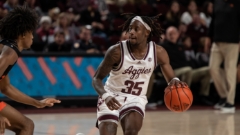
Manny Obaseki poised to emerge as X-factor for Buzz & Co. next season
After a breakout season for Buzz Williams and the Texas A&M basketball program that saw the team finish second with a 15-3 record in SEC play, expectations are high in 2023-2024 with the return of four starters and nine core contributors.
Despite a slow start early in last year’s campaign, the Aggies found themselves looking down in the conference standings to SEC bluebloods Kentucky, Arkansas, Auburn and Tennessee, to name a few.
While most of the league’s teams made wholesale roster changes in the offseason consistent with this new world of portal transfers and NIL deals, Texas A&M will benefit from continuity and an experienced roster of upperclassmen that have played together in Williams’ system and flourished under his culture for multiple seasons, which is very rare these days.
That doesn’t mean there aren’t areas for improvement and a few weaknesses to overcome heading into the 2023-2024 season.
In the first two installments of my offseason basketball series, we looked at the strength of the starting backcourt of First-Team All-SEC point guard Wade Taylor IV and Second-Team All-SEC selection Tyrece Radford. That’s a huge piece to next year’s success, and the team will run through what many pundits are calling the best returning backcourt in the SEC, if not the country.
However, the important third guard spot or the wing has an opening after the departure of fifth-year senior Dexter Dennis, who is now getting his shot at the NBA after exhausting his collegiate eligibility. Dennis’ production was consistent and valuable, scoring just under 10 points a contest, having a major presence on the glass with 5.7 rebounds a game, and being the team’s designated defensive stopper.
Texas A&M has several intriguing options to replace Dennis’ contributions, including offseason portal transfers Eli Lawrence from Middle Tennessee State (fifth year senior) and 6-foot-5 Illinois-Chicago junior transfer Jace Carter.
Perhaps the most intriguing candidate to fill that vacancy is third year guard Manny Obaseki who showed flashes of brilliance last season, but ultimately a hand injury at the start of SEC play derailed his sophomore season that leaves many observers wondering if the highly-rated prospect out of high school is prepared to transition from a supporting role off the bench to a featured resource in the starting lineup.
With a highly rated backcourt and a capable, experienced frontcourt running it back another season, Obaseki’s development and production at the third guard position could be a critical final piece to a 2023-2024 season with high hopes at a conference title and a run in the NCAA Tourney.
By The Numbers
Let’s compare Obaseki’s performances from his first two seasons in Aggieland along with his 2022-2023 team ranking in each of these statistical rankings.
| Category | 2021-2022 | 2022-2023 | Team Rank |
| Points/Game | 3.6 | 5.5 | 6th |
| Free Throw Percentage | 59.3% | 79.4% | 4th |
| Rebounds | 69 - 1.8 RPG | 28 - 1.5 RPG | 9th |
| Assists | 28 | 19 | 7th |
| Steals | 18 | 7 | 9th |
| 3-Point Shooting | 7 - 24.1% | 5 - 38.5% | 1st |
| Turnovers | 24 | 26 | 7th |
| Minutes/Game | 13.1 | 14.2 | 8th |
Scouting Report
Playing at Allen High School and then prep basketball power John Paul II, Obaseki’s long, muscular torso, freakish wingspan, and elite athletic ability intrigued national pundits and college coaches. Despite his skill set needing some further refinement, Obaseki’s natural athletic abilities were rare and he achieved five-star, high four-star status by most national recruiting services.
When the athletic lefty signed with Texas A&M more than two years ago, he was the highest-rated recruit signed by Buzz Williams in his tenure at Texas A&M.
Despite some ups-and-downs in his first collegiate season, Obaseki played in 38 games and started 17, averaging 3.6 points and 13 minutes a contest. He struggled with his offensive production and overall shooting in the half-court offense, which was expected coming out of high school where he thrived in the transition game by overwhelming the high school competition with his size, length, and athleticism.
His 35.3 percent field goal percentage and a treacherously low 24.1 percent three-point make rate was a big reason why his playing time decreased later in the season.

But as with many talented young players with next level potential, Obaseki improved his offensive skill set in several areas at the start of the 2022-2023 season, most importantly his three-point shooting, where he finished the year as the team’s number one three-point shooter by percentage at 38.5 percent. He also upped his overall field goal percentage by almost ten points to 43.4 percent.
Those numbers were reflected in several nice game performances in mid-December; he scored a season-high 14 points on the road in a big matchup with Memphis, and poured in 11 points against Oregon State.
Obaseki looked to be turning the corner in his young collegiate career by the start of SEC play in early January, but a significant hand injury in the conference opener against Florida required surgery and derailed the rest of his season. He missed the next 15 games. By the time he returned to the court, the team was on a roll near the end of the regular season and he never regained his minutes.
Before the injury, he averaged nearly seven points a game and 17 minutes on the court. After the injury, his playing time dropped to five minutes a contest, scoring 0.67 points a game.
So the big question in the offseason is whether Obaseki can not only regain his pre-injury form, but can he take his play to another level as a featured starter?
Looking at his pre-injury performance last season should give Aggie fans hope. During his improved production in mid-December, Obaseki took on more of a ball handler role and looked more comfortable creating off-the-dribble and attacking the basket in the half-court, which led to a lot more field goal opportunities in the paint and allowed him to utilize both his strength and physicality, as well as his incredibly long wing span and vertical jump to either score, go to the free throw line, or both.
That was huge for his effectiveness because Obaseki also improved his free throw shooting last offseason. As a freshman, he struggled, shooting 59.3 percent from the charity stripe, but that number popped to a 79.4 percent success rate in 2022-2023. That 20 percent difference was a game-changer along with his new confidence level to attack the rim. Unfortunately, Aggie fans didn’t get to see the fruits of Obaseki’s dribble-drive and free throw shooting improvements with the hand injury.
2023-2024 Areas For Improvement
While Obaseki showed improvement in his field goal shooting and free throw shooting, other areas of his game continued to lag in development. Turnovers have been an issue throughout his collegiate career, and he struggled last season, losing the ball 26 times in just 270 minutes. His turnover rate more than doubled from his freshman year.
Some of that was due to his increased ball handling role as a sophomore, but turnovers by guards usually lead to easy transition buckets.

Taylor also had a higher than average turnover rate last year, so this isn’t just an Obaseki directive. Texas A&M guards must protect the ball better next season if they want to achieve the high expectations that have been established by the national media this offseason.
Also, given his size, length, reach and vertical leap, Obaseki must improve on his rebounding and become more of a presence on the defensive glass. Dexter Dennis was a hawk on the boards, averaging 5.7 per game. Obaseki has averaged 1.7 rebounds in his first two years. The math doesn’t add up. That number must go up in a big way.
Manny created only seven steals last season. Given his incredible wingspan and overall athleticism, he should be creating more loose ball opportunities.
Importance For 2023-2024 Team Success
It’s so important for a team to have a guard who can create off the dribble, go to the charity stripe and make free throws. In this day and age, free throws have become a lost art and finding that resource is becoming more difficult, but very, very critical to any college team’s success.
You don’t hear about it that much, but a big part of Texas A&M’s success last season came from improved free throw shooting. Returning players collectively shot 66 percent from the line in 2021-2022. That number shot up to 76 percent last season primarily due to Taylor (87.5 percent) and Radford (80 percent).
Now, add in a third guard like Obaseki shooting 79.4 percent, and Texas A&M potentially has three guards at a minimum who can create off the dribble, get to the free throw line, and make over 80 percent of their free throws.
That’s a winning formula in college basketball… period.
That’s why one of my biggest storylines in this offseason is the continued development and improvement of the Allen, TX native coming off hand surgery. Does he start where he left off with his injury last January, and continue with the upward trajectory of his career, or does he struggle to find his game having missed essentially the final three months of the season?
If the answer is yes, that will be huge for the team. A productive, attacking Obaseki at the third guard spot to go along with the returning All-SEC backcourt of Taylor and Radford starts to look pretty salty on paper. Most good coaches can scheme a defense to take away one or even two opposing playmakers.
However, a clipboard can’t defend against three playmakers with the ability to attack the basket, get to the free throw line and make shots.
Thus, in that context, the development of Manny Obaseki becomes a significant storyline to the 2023-2024 season. I think we all expect Aggie basketball to be good next season, but HOW good could come down to the performance of the former five-star prospect from the Metroplex.
